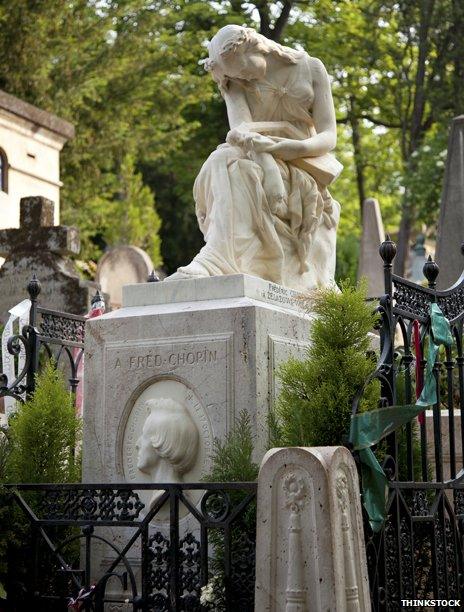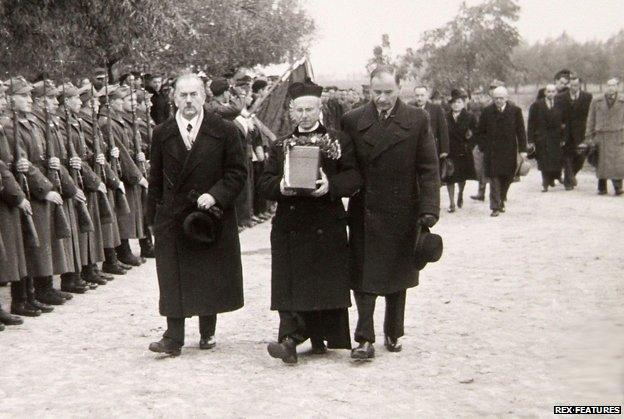The mystery of Chopin's death
- Published

When Polish composer Frederic Chopin died in 1849 he seemed to have suffered a classic Romantic death from tuberculosis. But doubts soon arose about the diagnosis, and a scientific examination of the heart earlier this year, while at first appearing to confirm the TB theory, left the mystery unresolved.
It was the dead of night when a secret ceremony took place at a church in the Polish capital, Warsaw, in April this year. A crystal jar, encased in one of the church's pillars, was removed and its contents examined solemnly by genetic and forensic scientists.
"The spirit of this night was very sublime," forensic scientist Tadeusz Dobosz told the Associated Press news agency.
The jar contained a heart preserved in alcohol - most likely cognac - for more than 160 years. It belonged to arguably Poland's most famous son, the great composer and pianist Frederic Chopin. The scientists wanted to check that it was in good condition and to answer the question - what killed the man whose works are regarded by Poles as the musical embodiment of their country?
Chopin died in an apartment in Place Vendome, in Paris, on 17 October 1849, at the age of 39. France's greatest authority on tuberculosis had diagnosed him with the disease months earlier, and duly noted it as the cause on the death certificate.
But things then became less clear. The same doctor, Jean Cruveilhier, removed Chopin's heart and carried out an autopsy. Precisely what he recorded is not known - the notes he made were lost. However, reports suggest he referred to something other than TB, a "disease not previously encountered".
What could that be?
Eventually new theories began to emerge. One medical paper suggested cystic fibrosis, external - undiscovered in 1849 - was the killer. Another, that Chopin had inherited a form of emphysema, Alpha-1-antitrypsin deficiency, external.
Then in September, the debate appeared to be over. The forensic and genetic scientists who had gathered months earlier at the Holy Cross Church in Warsaw for that unprecedented examination revealed their conclusions at a news conference.

Chopin's heart was well preserved and bore "TB nodules" they reported. It was also "much enlarged, suggesting respiratory problems, linked to a lung disease".
It looked like TB, after all. End of story.
But the examination was only visual. No tissue sample was taken for testing. The jar bearing Chopin's heart had not been opened, and had never left the church.
Is a visual examination of a heart inside a jar enough to give conclusive proof of TB? Sebastian Lucas, Emeritus Professor of Pathology at Guy's and St Thomas' Hospital in London, says probably not.
"If the heart was involved in the TB, it would in many cases be affected by pericarditis, an inflammation around the heart," he says.
"TB pericarditis can be nodular or a diffuse process. Nodules sound good for TB as the diagnosis, but other diseases can mimic that appearance - cancer, and a fungus infection such as aspergillosis. You can't tell which one by the naked eye."
The scientists who carried out the examination had wanted to open the jar and test its contents, but faced implacable opposition from "everybody, starting with the great great granddaughter of one of Chopin's sisters", Prof Dobosz said in September. Other opponents, he told Gazeta Wyborzca, included the previous director of Poland's Chopin Institute and the Archbishop of Warsaw, Cardinal Kazimierz Nycz.
To understand this opposition, it's worth considering what Chopin means to Poland.

Frederic Chopin 1810-1849

Child prodigy of a French father and Polish mother, whose playing was in demand among the aristocracy of Warsaw
Had a Polonaise published when he was aged only seven
Wrote Nocturnes and short pieces in dance forms, such as Mazurkas, Waltzes and Polonaises, throughout his career

The composer left Warsaw aged 20, never to return. Throughout his life Poland did not exist. It had been swallowed by Russia, Prussia and Austria in 1795, and only re-materialised as an independent country 123 years later.
Chopin's patriotism found expression in his music, and for Poles it came to symbolise Polish nationalism. His dying wish was for his heart to be removed before burial - in Paris's Pere Lachaise cemetery - and his sister then smuggled it past Russian guards into Poland.
Many years later, in September 1939 the pianist Wladyslaw Szpilman happened to be in the middle of a live broadcast of a Chopin nocturne when German bombs fell on the radio station and he was forced off air. On his return to Warsaw Radio in 1945, having survived the utter destruction of the city and the Holocaust, he began by playing the same nocturne - a story immortalised in Roman Polanski's film The Pianist.
Wladyslaw Szpilman plays part of Chopin's Nocturne in C Sharp Minor
To meddle with the heart of a man so bound-up with the struggles for Poland would, for many Poles, be sacrilegious.
"There would be a feeling of desecration," explains Rose Cholmondeley, president of the London-based Chopin Society. "It's like a holy relic, and there is something distasteful about DNA analysis."
But Cholmondeley also thinks there could be another reason why a DNA test might make people uncomfortable.
"It's not absolutely certain it's Chopin's heart," she says.
The legend is that a German soldier removed the heart from its pillar in the church during the war, before both the church and the pillar were flattened. It is then said to have passed through a variety of hands before being returned to a Polish cardinal.
In a bizarre twist, one of the men who supposedly looked after the heart and saved it from destruction is the same man who carried out that destruction - SS Gen Erich von dem Bach-Zelewski, commander of the German forces that put down the Warsaw Uprising with great brutality in the summer of 1944.
But as Rose Cholmondeley says, it's hard to know how much of this is true, and the possibility remains that the heart reinterred in the pillar of the church in October 1945, amid patriotic celebration in the ruins of a devastated city, is not Chopin's.

Prof Dobosz disagrees. The April inspection, in his view, dispelled these doubts.
"The condition, the appearance of the preservative, the type of thread used for stitching the heart following dissection in Paris, the type of jar - all, in our opinion, are of the era," he said during the scientists' news conference.
The jar was resealed in the church pillar, with a recommendation that it be left undisturbed until 2064.

What is TB?

Serious condition caused by bacterium mycobacterium tuberculosis, external
Mainly affects the lungs, but can affect other parts of the body, including bones and nervous system , external
Was a major health problem in 18th and 19th Century Europe and North America, but was brought under control in 20th Century by improved hygiene and antibiotic treatment
Remains a fatal disease in countries where population is dense and hygiene is poor

The diagnosis of TB could be regarded as inevitable in Chopin's case.
He was a deeply Romantic figure. The stirring passion and emotion of his music led his German contemporary Robert Schumann to describe it as "cannons hidden among flowers".
And Chopin's appearance - thin, small, very pale - corresponded to the stereotype of the Romantic consumptive.
"Chopin coughs with infinite grace" wrote his lover, the novelist George Sand.
Prof Clark Lawlor of Northumbria University has published a book on the depiction of consumption in literature. The first half of the 19th Century saw TB eulogised as the way for an artist to die, he says. If a fatal illness could ever be considered attractive, than it was TB.
"It's a bit like heroin chic," says Lawlor, "A Romantic idea of consumption as the glamorous disease of the beautiful and the genius. How can any disease be fashionable, how can any disease be Romantic? But it reached this paradoxical position in the 19th Century."
It's tempting to see a blurring of fact and fiction in Chopin's death. But even so, the original explanation of what killed him may still be the most credible one.
"TB was the single most common cause of death in Europe and North America. It was an enormous killer. On a statistical basis, he died of TB rather than Cystic Fibrosis," says Prof Lucas.
While he agrees that Chopin did exhibit some of the characteristics of a CF sufferer and someone affected by Alpha-1-AT, he says they could all apply just as well to someone with TB.
He also doubts whether any testing of tissue now could prove conclusively what killed Chopin, and for that reason his heart - assuming it is his heart - should be left to rest in peace, he says.
"Histopathology of the pericardium might indicate TB, but if it's normal no disease is proven or excluded. Genetic tests for CF would probably be inconclusive. So that's why I don't think they should do it."
No-one may be able to say conclusively what killed Frederic Chopin.
But the Church of the Holy Cross in Warsaw will continue to be a place of pilgrimage for Chopin devotees - convinced that the heart resting there is that of the greatest of all Polish patriots.

Musician's musician

"Hats off gentlemen, a genius!" - Robert Schumann
"A really perfect virtuoso" - Felix Mendelssohn
"A sickroom talent" - John Field
"He shines lonely, peerless in the firmament of art" - Franz Liszt

Subscribe to the BBC News Magazine's email newsletter to get articles sent to your inbox.